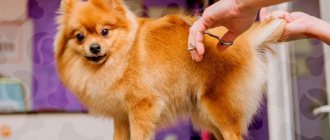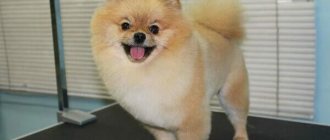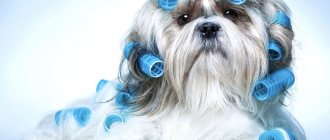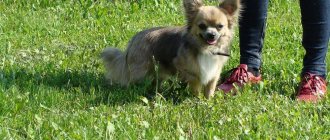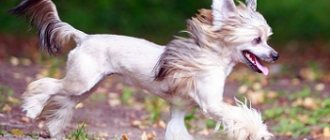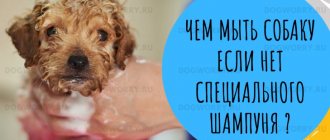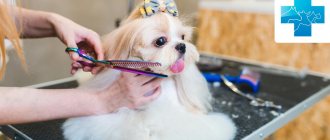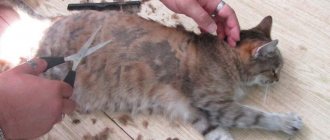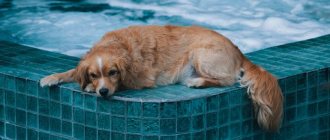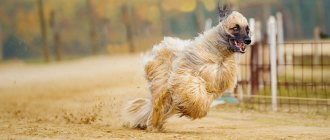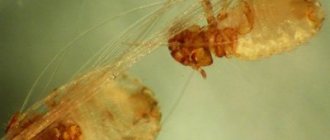The Miniature Schnauzer is an original and charismatic breed of dog. It is distinguished by a luxurious exterior. He boasts long bangs and an impressive beard, and his thick, wiry coat is a delight to look at.
The impeccable beauty of the Miniature Schnauzer is not a gift from nature, but the result of the long and painstaking work of the groomer. Be sure to study the basic rules for caring for a small representative of this breed and remember the golden truth that a dog is a mirror image of its owner.
What types are there
According to its purpose, grooming of this breed is divided into several types.
Cosmetic (hygienic)
Must be done once a month. It includes: combing the undercoat, trimming the hair on and around the paw pads, removing hair in the ears, trimming the hair on the ears, trimming the beard and bangs, removing excess hair in the groin area and under the tail.
Base
Carry out once every 2-3 months. Its procedure includes trimming dead fur (undercoat) and trimming it along the body, as well as all the listed hygiene measures.
Seasonal
Particularly important during the period of active molting of the animal (2 times a year). Between seasonal grooming, hygienic and basic grooming are required.
Exhibition
Necessary for preparing the dog for the ring and show events.
Incorrectly carried out grooming can ruin the dog’s appearance and cause the Miniature Schnauzer to be deprived of promising exhibitions. Trust your pet in the hands of a professional groomer who knows the characteristics of the breed.
Features of the coat
The official breed standard states that the Miniature Schnauzer's body is covered with two-layer hair. A thick undercoat is hidden under the not too short awn. True, it does not indicate that dog spines are divided into 3 types:
- young (shortest);
- ripe (medium);
- old (longest, hardest and dullest).
Dead hair does not perform any important functions other than protecting the dog from pollution. The old coat worsens the dog's appearance and begins to fall out over time. As a result, without appropriate grooming, the dog looks unkempt and does not receive high marks at shows.
On a note. The Miniature Schnauzer's hair grows in layers. But only part of the fur falls out on its own. The rest is carefully removed, trying not to touch the bottom layer.
Haircut scheme
Sketchy cutting and trimming a Miniature Schnauzer is not an easy task, especially when it comes to preparing it for an exhibition.
Mature hair is trimmed along the body, starting from the neck, smoothly moving along the back and sides towards the tail. The hind legs are usually trimmed to the hocks.
The following areas can be cut with a clipper: the inside of the neck, the area under the tail and the ears.
Scissors are used to trim the muzzle and bangs, front and hind limbs and the lower line of the body.
An easier way is to cut it with a clipper, without any special frills. In this case, the neck and back are cut short, the hair on the paws is trimmed with scissors, and a so-called skirt is left on the stomach. The beard and bangs, in this case, emphasize the breed.
Muzzle trim
The Miniature Schnauzer's muzzle is his calling card. She is adorned with a massive beard and elegant bangs. The muzzle must be properly designed and always well-groomed. Considering the fact that a beard constantly gets dirty, caring for it is especially important.
The length of the beard can vary, but should not be short. The hair on the muzzle is combed down from the extreme corner of the eye, and on the bridge of the nose, parted in the middle.
Next, the beard is trimmed with scissors and, if necessary, thinned. Closer to the nose, the beard is slightly shorter than in the cheekbone area. The bridge of the nose is not trimmed.
The bangs are a decoration for the Small Schnauzer. It falls over the eyes, but does not cover them completely. The bangs can be short or long, straight or oblique, or in a trapezoid shape. In any case, its presence is mandatory. When forming bangs, long hair from the forehead is combed down to the eyes (1.5-2 cm wide) and then trimmed.
The absence of bangs and beard is not stipulated by the breed standard.
Dog grooming
In addition to trimming, the Miniature Schnauzer needs basic hygiene procedures. Caring for your dog comes down to periodic bathing and regular brushing:
- Before combing, the coarse coat of the miniature is moistened with conditioner and only then treated with a slicker or metal comb.
- Bathe your Miniature Schnauzer as it gets dirty. Bath procedures are carried out in a warm room using shampoo for wire-haired dogs.
Grooming and trimming a miniature schnauzer is not a tribute to fashion, but a necessity that helps maintain the health and aesthetic appearance of the animal. A plucked and trimmed dog will become the real pride of the owner and will receive high marks from experts. In Moscow and other large cities there are many salons staffed by skilled grooming specialists. But it is much more pleasant to realize that the appearance of a miniature dog, arousing the admiration of others, is the merit of the owner himself.
Trimming
The procedure of trimming (plucking) hair for all representatives of the Schnauzer family is a mandatory event. Trimming has a number of positive factors:
- Emphasizes the advantages of the breed.
- Helps the dog get rid of dead hair faster.
- Deprives the owner of the problem associated with dog shedding.
- After professional trimming, the new fur grows silky and elegant.
It is recommended to start accustoming your Miniature Schnauzer to trimming at 3.5-4 months. This is necessary so that the dog quickly gets used to the atypical sensations and manipulations of the groomer.
When trimming, hard hairs are schematically and carefully plucked from the neck to the base of the tail, and then the area of the shoulder blades is worked on. At the end, the sides and chest, hips and tail are trimmed.
Trimming is carried out using a trimming knife. The work is carried out as follows:
- A small section (tuft) of fur is lifted with the thumb, while the remaining fingers hold the skin.
- The tuft of wool is pryed off with a special knife (trimmer), and then it is pulled. In this way, all the necessary areas on the dog’s body are worked out.
- After trimming, the dog’s skin is treated with antiseptic agents, and in the cool season it is advisable to walk in protective overalls.
A little about the Miniature Schnauzer breed
Miniature Schnauzer after trimming
The pedigree of the Miniature Schnauzer breed goes back almost a century and a half. It was registered in Bavaria in the late 80s of the 19th century, and 10 years later miniature schnauzers began to take full part in international dog shows.
It is believed that the ancestors of schnauzers were pinschers, whose offspring sometimes produced puppies with coarse, long hair. To develop a mini-breed, schnauzers were crossed with poodles, German Spitz, and Affenpinscher. As a result of selection, dogs appeared of a more miniature size with a specific coat color (black, white, black with a silver tint, and salt and pepper colors). A special feature of this breed is its unique ability to make facial expressions.
Due to its small size, the breed of these dogs received the prefix “zwerg” (from the German zwerg - midget) to the main name schnauzer.
Despite their relatively small size (weight - up to 10 kg, height - 35-40 cm), miniature schnauzers have developed intelligence, an extroverted character, a highly developed protective instinct, lightning-fast reaction and good physical qualities. Thanks to these abilities, miniature dogs are often used by customs and police officers - currently they are the smallest service dogs in the world. On a note! The main requirement of the breed standard is a hard coat structure, which can be achieved by completely plucking the hair over a period of 2-3 years.
Step-by-step haircut instructions
- Place the dog on a table with anti-slip rubber coating.
- Comb the wool from tangles, remove them using a tangle cutter or thinning scissors.
- Then wash the dog and dry thoroughly.
- The body is trimmed with a clipper, the hair is kept short, but the dog is not completely exposed.
- A body haircut is carried out against the growth of the hair, starting from the tail and ending where the bangs grow. The hips are cut from the outside in the shape of a pointed triangle.
- The hair on the belly, chest and limbs is not cut, but combed out and trimmed along the contour with scissors.
- The ears are trimmed on both sides.
- The beard and bangs are trimmed with scissors.
- The paw pads are trimmed to remove excess hair with a trimmer, then the fur on the paws is given a rounded shape using scissors.
Application of the machine
The Miniature Schnauzer clipper is used for zonal trimming of the coat, as well as for complex and model haircuts. The machine must be highly professional, powerful, high quality, equipped with sharp steel knives.
Models of clippers of various types (category ZOO) from leading manufacturers can easily cope with the coarse coat of Schnauzers and their thick undercoat.
Using a comb
For daily care of the Miniature Schnauzer, the owner should have various types of combs in his arsenal. They are a basic tool. Only high-quality combed wool can be further trimmed and subjected to rolling and trimming procedures.
- Combs must be metal, have blunt tooth ends, and be more than 1 cm long.
- The frequency of the comb teeth depends on the dog’s coat, thickness and stiffness.
- It is advisable to have 2-3 combs. One with long and rare teeth for preliminary work, and the second with more frequent teeth for control combing.
- Rake-type combs with rotating teeth help to better cope with the task of combing wool.
- Combs with curved tips add extra volume to the hair.
- The slicker is not large in size, the length of the sides of the head is 5-7 cm, and is also important in caring for the Miniature Schnauzer.
The need for a furminator
For owners of Miniature Schnauzers, there is a clear need for weekly use of the Furminator.
Having such a useful, strong and high-quality tool in your arsenal, you can easily remove dead undercoat without damaging the dog’s outer coat.
General rules
When processing the cover, it is important to take into account the nuances and know what features step-by-step haircuts have by area:
- the cover is two-layered, consisting of dense undercoat and fairly short guard hair;
- There are different types of hairs on the dog’s body: new, very mild plus tousled, medium length plus coarse and long, dying elements. It is the last category that gives the animal’s coat an unkempt appearance; the coat loses its smoothness and shine.
A characteristic feature of miniature schnauzer haircuts is the treatment of local zones:
- Use scissors to trim the beard, give the eyebrows the correct triangular shape, and trim the hairs on the front and hind legs. For a smooth transition, the formation of a small “skirt” into the cover on the chest area, these areas are carefully processed;
- With the help of a clipper they cut the area of the ears, belly, areas around the pride and cheekbones. Additionally, the hair around the genitals and anus is shortened.
The fur around the paw pads grows back quite quickly. This area must be passed through with small scissors.
There is an important difference in grooming between a miniature and, for example, a Yorkshire terrier. For the wire-haired dog breed (miniature schnauzer), the main emphasis is on trimming and rolling - removing hairs (bristles) by plucking the coat. Pets with soft, silky hair (Yorkies) require regular hygienic haircuts.
Pets with soft, silky hair (Yorkies) need regular hygienic haircuts.
Types of haircuts:
- cosmetic. Trimming the cover with a machine and scissors is performed as the hairs grow. Be sure to cut off part of the cover between the paw pads so that the hairs do not bother the dog. The best option is to do “cosmetics” every one and a half to two months. During the procedure, the overgrown undercoat is combed, hairs are cut off in the genital area, areas near the tail, neck, and decorating “columns” on the paws are trimmed;
- basic. The classic option is a combination of trimming with leveling and shortening the length on the chest and “skirt”, belly, ears, giving a characteristic shape to the beard and eyebrows;
- exhibition. The basis of preparation for exterior competitions is a cosmetic haircut in a pet salon. Before the procedure, the dog is bathed, dried with a hairdryer, and a special balm is applied. Additionally, overgrown hairs on the paws are cut off, and the stages of a classic haircut are performed so that all areas have clear shapes according to the standard.
Important details:
Plucking dead, tousled hairs is the main care for a miniature schnauzer's coat. Model haircuts are rare. Before exhibiting your pet, be sure to perform cosmetic work on limited areas. Without plucking coarse hair over the entire surface of the body, the pet will have an unkempt appearance. Machine grooming of a dog on all parts of the body degrades the quality of the coat. With proper trimming in the first year of life, the coat becomes smoother, the coat takes on a look that meets standard indicators by the age of two. Strong plucking of hard hairs on the dog’s body must be carried out taking into account the rules, otherwise the growth of the coat can be disrupted and the quality of the undercoat may deteriorate. Every five weeks you can trim the wool (from 10 to 30%). The procedure is called rolling. Addition – cosmetic haircut and hygienic treatment on paw pads
It is important to lubricate the decorating coat with a special balm and conditioner. When rolling is performed correctly, the dog looks perfect, the length of the coat is from 1.5 to 2 cm, the pet does not look “bald” and “bald”, as after full trimming, if the owner does not perform rolling, but waits for the dog to completely “overgrow”. On a note! If the owner wants to cut the dog’s hair and pluck out dead hairs on his own, he will have to work hard: processing dense, coarse hair is a difficult task for a non-professional
It is useful to visit a grooming salon for the first time, watch the master’s work, learn the nuances, and only after that carry out the hair treatment. Incorrect actions can cause pain to the pet and disrupt the structure of the integument.
On a note! If the owner wants to cut the dog’s hair and pluck out dead hairs on his own, he will have to work hard: processing dense, coarse hair is a difficult task for a non-professional. It is useful to visit a grooming salon for the first time, watch the master’s work, learn the nuances, and only after that carry out the hair treatment. Incorrect actions can cause pain to the pet and disrupt the structure of the integument.
It is important to ensure that the dog does not become too “bald” after the procedure. Optimal treatment of the coat allows you to achieve ideal coat condition without ruffled and unkempt areas
Basic Rules
The Miniature Schnauzer breed has special grooming rules that cannot be neglected. Shedding in these dogs does not occur independently and requires human intervention.
Otherwise, an exceptionally handsome man can turn into a shaggy creature of an unknown breed.
The Miniature Schnauzer's coat consists of two layers:
- The first layer is a dense and thick undercoat.
- The second layer is the spine, longer and tougher.
Depending on the life cycle, guard wool is divided into types:
- The young ones are soft, thin and short.
- Mature – medium length, more rigid.
- Old – long, dead, most rigid or faded.
Mature guard fur is plucked according to a certain pattern. The Miniature Schnauzer needs competent, timely trimming and zonal cutting with scissors and clippers.
Origin story
The words “miniature” and “schnauzer” in translation mean “gnome” and “muzzle”. The breed is called young, but its roots go back to the Middle Ages. It is known that the ancestors were miniature schnauzers. There is a version that a branch was formed on the territory of modern Germany. Representatives of small schnauzers appeared in the German expanses in the 19th–20th centuries.
The brave animals were used to guard homes and catch rats. Representatives of mini-schnauzers appeared at the exhibition only in 1899. They were spotted there. And in the same year the first breed standard was developed. Schnauzers of unusually small size came to Russia in 1974, and breeding began in 1988.
Rolling and its secrets
The main task of rolling is to create the appearance of the Miniature Schnauzer in such a way that he is ready to appear before the audience and judges at any moment. In this case, the owner will not have to miss the exhibition due to the pet’s fur not being ready.
Rolling has a unique specificity. It is recommended to accustom a puppy to it at the age of 3-3.5 months, and if desired, you can also transfer an adult who has previously been trimmed to rolling. However, this will be a little more difficult to do.
The purpose of rolling is to form a three-layer coat in the Miniature Schnauzer. This will require not only skill, but also patience. Let's look at the rolling procedure step by step.
Stage 1 – Formation of the 1st layer of wool (top)
At this stage, the puppy hair that sticks out in different directions is removed. The pinching procedure is carried out throughout the body by hand and evenly. After trimming, you need to remove the undercoat using a furminator. Next, the undercoat is combed and removed weekly.
Stage 2 – Formation of the 2nd layer of wool (middle)
28-35 days after the first plucking, it is time to work with the 2nd layer of wool. Don't be alarmed that the coat will be unsightly and uneven at this time.
At this stage, it is important to be patient and evenly pluck any stray hairs.
During the work, you will be able to observe short and spiky hairs on the dog’s body - this means that the growth of new guard hair, removed at stage 1, has begun. This means everything is going according to plan, and soon your little schnauzer will shine with dazzling beauty. Don't forget to remove the undercoat once a week.
Stage 3 – Formation of the 3rd layer of wool (bottom)
After 28-35 days, it’s time to remove the remnants of old and long hair. Having removed it, you can see the beautiful young, hard guard hair, which has grown safely since the first plucking. It is still quite short and consists of 2 layers, top and middle.
The dog looks quite neat at this time, but it still needs some time to build up the 3rd (bottom) layer. In about 1 month it will be safely formed.
Thus, if you roll every 4-5 weeks, you can achieve perfection. In this case, the Miniature Schnauzer will always look elegant and well-groomed.
It takes approximately 4.5-5 months for a 100% transition to rolling.
Schnauzer diseases
These pets have excellent health, which is why they are considered long-livers.
But even strong individuals may experience some ailments. The most common diseases of the breed include:
- hip dysplasia;
- allergies;
- dermatitis;
- hypothyroidism;
- pancreatitis;
- epilepsy;
- cataract;
- bloating;
- urolithiasis;
- oncology.
Characteristics of the schnauzer in the table
| Breed name | Schnauzer |
| Country of origin | Germany |
| Time of birth of the breed | until the 18th century |
| Type | protector, tracker, friend |
| Weight | 5-8 kg; 14-20 kg; 34-47 kg |
| Height (height at withers) | 30-35 cm; 47-50cm; 65-70cm |
| Lifespan | 12-15 years |
Schnauzer video
Schnauzers are three varieties of the same breed. Pets are distinguished by size.
All dogs have similar personalities. All three species are trackers and good defenders. They are loyal and friendly to all members of their family. These pets really need an active life. Just sitting at home and waiting for an evening walk is not for them. Large breeds can live in enclosures on the property near the house, but miniatures (small pets) can only live in apartments.
Exhibition grooming
Exhibition grooming for a miniature schnauzer
Exhibition grooming for a miniature schnauzer includes a step-by-step set of grooming procedures to prepare for exhibition. It includes:
- Rolling. For show miniature dogs, to maintain the maximum level of coat condition, it must be performed at least once every 1-1.5 months. Puppies should be taught to roll at the age of 3-4 months; later the dog learns the lessons more difficult and gets used to uncharacteristic pinching and twitching. Regular implementation of the procedure contributes to the formation of a multi-layered coat in accordance with breed standards.
- Trimming. The breed requirements of show dogs are mandatory trimming of the schnauzer in the body area (dorsal area - from the back of the head to the croup). Unlike miniature schnauzers and giant schnauzers, the coat length of miniature schnauzers should not exceed 1.5 cm. In the process of preparing for an exhibition, two trimming procedures are performed - one 2 months before the event, the other at least 2-3 weeks before the start of the exhibition. The main goal of an exhibition miniature schnauzer trimming scheme is the correct length of coat, breed hardness and fulfillment of aesthetic requirements in accordance with the breed standard.
Note! The black color of the coat and brown undercoat in miniature schnauzers signals an increased intensity of hair growth. Such dogs need more frequent trimming - at least 8-9 times a year. Grooming a miniature schnauzer will not only preserve the beautiful appearance of the pet, but will also prolong its youth and health
Regular implementation of hygienic salon procedures is an effective prevention and prevention of the development of pathological changes in the coat and skin of dogs
Grooming a miniature schnauzer will not only preserve the beautiful appearance of your pet, but will also prolong its youth and health. Regular implementation of hygienic salon procedures is an effective prevention and prevention of the development of pathological changes in the coat and skin of dogs.
